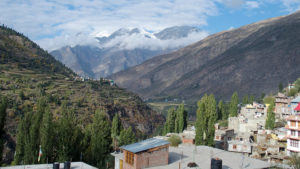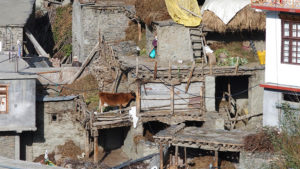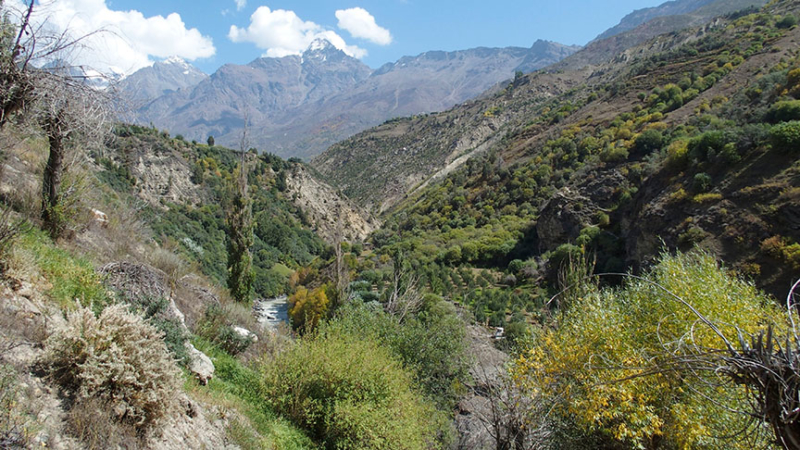Monsoon season was drawing to an end so we started to feel comfortable with the idea of heading south through Himachal Pradesh and eventually working our way toward Nepal. No rush. Let’s just take our time and explore the mountains. On the brutal bus ride north we had a short stop for about 12 hours in a very small town called Keylong and it lodged itself in my mind as a beautiful valley with a lot of nice possibilities for long day hikes. I couldn’t find much information about it anywhere but we knew it had some hotels so we took a night bus from Leh to Keylong and counted on just walking around to find a place to stay.
We easily found a room near the bus station and the scenery was so enticing that we planned on sticking around for a couple of days. Our hotel was comfortable but it was really noisy all day and night so we branched out to look for another place that wasn’t around the bus station. The strange thing was that there were plenty of hotels, and many more being built, but almost nobody came to Keylong for the sake of spending time in there. They spent one night there as a resting point between Leh and Manali. Once we got away from the bus station we discovered a charming town rich with character.

Keylong is one of the larger settlements in Lahaul, which has much in common with it’s northern neighbor Ladakh. Both are high in the rugged mountains and sparsely populated. They both have a way of life that is very old and is built on self-sufficiency for they are isolated and remote, especially during the winter. The valley that Keylong sits in is much greener than Ladakh but still relatively dry. There are gorgeous terraces carved into the mountainsides for farming potatoes and Buddhist monasteries are perched in precarious places high in the nearly inaccessible rocks.

Meandering through older parts of town we saw homes built of stone and mud, which the old-timers insist is superior to concrete. Cows play an important role around here, even more so than in Leh, and many of these old homes have special levels and compartments for the cows and their food which are reached by wooden ladders. It reminded me of M.C. Escher’s drawings of geometry defying structures. How on earth did a cow get to that particular spot? Hay is piled in huge mounds on the tops of buildings and vegetable scraps are thrown into other areas for the cows to eventually eat. Breathing, mooing, composting machines. They are very well cared for, almost like members of the family. I don’t think anyone eats the cows but people definitely get a lot of fresh milk from them, and thus homemade ghee (clarified butter), paneer (cheese), and curd (yoghurt).

The cows are strategically taken out to graze in the terraces for clearing and fertilization with their droppings. In such a rocky landscape I’ve wondered how it ever became possible to grow crops here. I imagine a cycle that has occurred over hundreds of years where rocks are slowly dug up and moved by hand to create terrace walls and erosion naturally spreads the thin dusty soil to fill the terraces, which exposes more rocks to move. Cows would be grazed and some controlled burning may take place to build fertility in the soil. It would take a long time but the result is arable land where there used to be a steep rocky mountainside and if the process is continued it could pretty much last forever. That’s just my best guess. Valuable cow patties that don’t end up in the soil are collected, molded into perfect cakes, and stuck to the sides of stone walls to dry in the sun. I’m assuming this is for fuel but I suppose it could be used in other ways like long term fertilizer storage or even as an ingredient in the mud mixture for building. Deliberately placed finger dimples probably help them dry faster but also give the impression of a wall covered with giant chocolate chip cookies.

As in Ladakh, people were preparing for winter even though it was still what I would call summer. Potatoes were being harvested everywhere, dug up by hand, placed into burlap bags, packed onto horses, hauled to the main road, and loaded onto trucks to be distributed throughout India. There were other crops being harvested, mostly for personal sustenance – cabbage, cauliflower, grains, squashes, and herbs. Cellars were filling up with piles of hardy vegetables for the winter.
Dawa, the man who owned the hotel where we were staying, was a kind and gentle soul and we developed a friendly relationship with him. He took us to his family home one day and showed us around. The cows were happy, we saw the piles of vegetables in the cellar, we sat and had curried chick peas with rice and a nice dollop of pungent homemade ghee. It tasted nothing like the stuff we were buying from the store – more of a rich aged cheese-like flavor. He showed us old photos of previous generations of his family and we saw the prayer room, which was like a temple stuffed into a tiny room, complete with a large prayer wheel taking up about a third of the space.
He referred to many things as “his” but it became clear after a while that there was no real distinction between things that he considered his own and things that belonged to his family as a whole. His family was large and had various resources spread around the area and they combined efforts to promote the general family welfare. Extended family members moved around through this network, living and working in various households. They have a pretty nice thing going and it seemed like a core principle for Dawa to not only share everything with his family, but also to reach out and provide opportunity for those in his community who were less fortunate. One example that stood out to me was that he employed several young men at the hotel and he offered to pay them and provide a place to stay in the hotel even when there was no business because winter was on its way and things were completely shutting down. These guys had no other family in the area and nowhere else to go, other than to move south and look for work somewhere else.
We met Dawa by walking around town and looking for a place to stay that was not by the noisy bus station, but more in the town. We saw one big place right off the main road and figured it would be way too expensive but it was worth looking into. It did have one of the best views around but it wasn’t nearly as fancy on the inside as we thought it would be. And it was almost completely empty so Dawa gave us a nice deal to get somebody in there. We decided to stick around for a while, get to know the town, and go for some nice long walks. We had two balconies. One looked west over the town, through the valley, and ending with some massive mountain peaks off in the distance. The other looked over the main street through town. We could lay in bed and watch the rising sun light up the mountains to the west and drink our morning tea while we watched the men walk around in their wool vests saying good morning and shaking everyone’s hands.
Many people pass through Keylong and spend one night there, using it only as a pit stop. Busloads stumble in and out in less than a day. Groups of touring motorcyclists give it maybe two days. I found Keylong, and the walkable surrounding area, to be an incredibly interesting and beautiful place and I know Fern feels the same way. Maybe the locals don’t want it to become a booming tourist destination. They’re a quiet, reserved, and respectful people and it would be a shame if that changed because of the effects of tourism dollars and hasty overdevelopment. They have a lovely way of life and a gorgeous environment and I hope it stays that way for a long time.
jim@snorkelbandits.com


